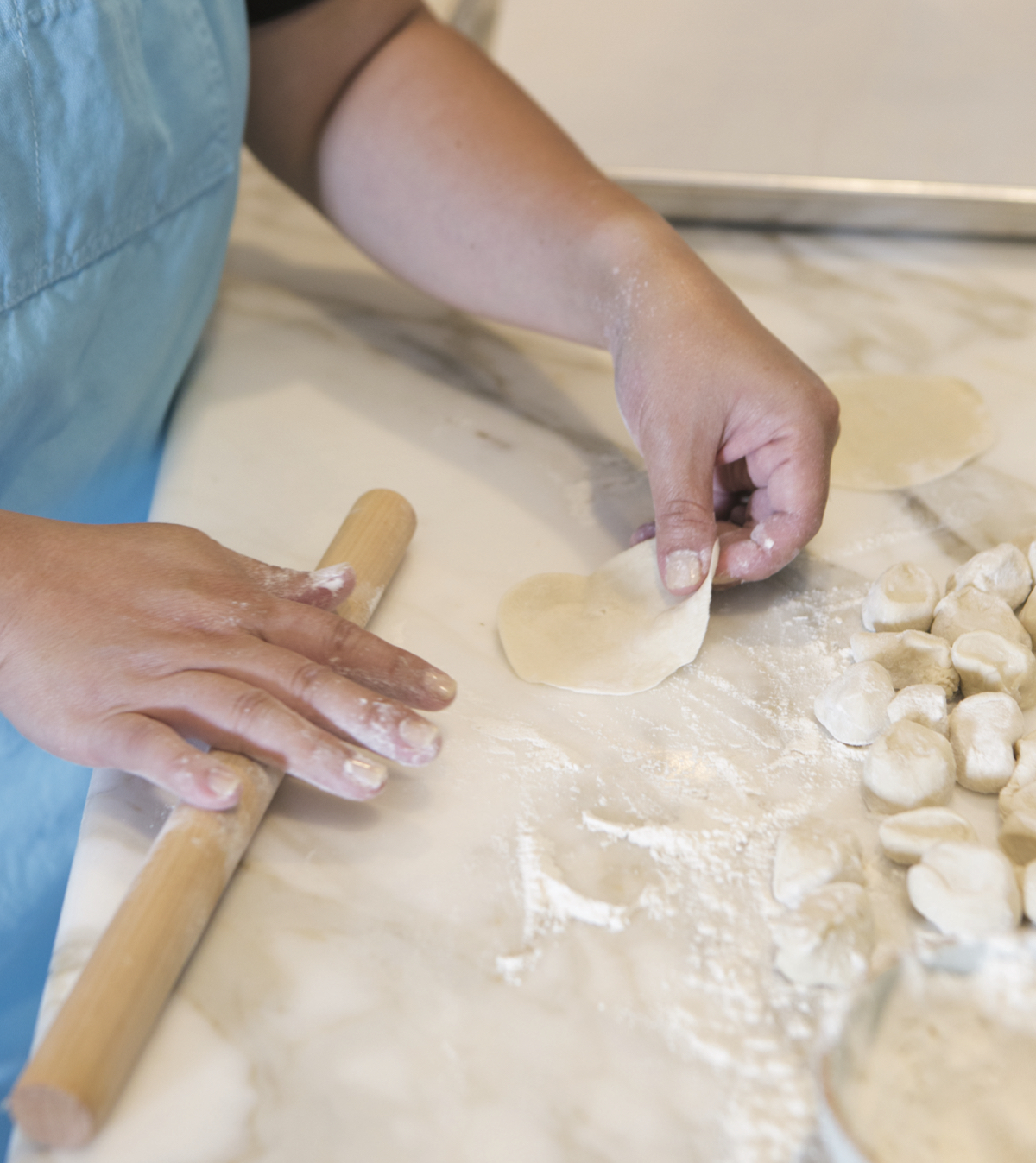I Promise You Really CAN Make Dumplings at Home
Dumplings are one of those items that feel like you have to eat them only when you go out. They seem complicated when actually they are a simple staple that everyone makes at home.
I felt so lucky to have Hsiao-Ching Chou stop by the test kitchen because the minute I picked up her new book, Chinese Soul Food, I knew it was a keeper. It somehow finds the middle of the road between being authentic but still easy for people who aren't as familiar with Chinese cooking. So I thought we would start with the basics and learn how to make dumpling dough. With just flour and water and Chou's tips anyone can do it.
Dumpling Dough from Chinese Soul Food by Hsiao-Ching Chou
All-purpose flour and water. It really doesn’t get more straightforward than that. What takes practice is using your eyes and sense of touch to determine just how thirsty the flour is on a given day, because the moisture content of the flour and the humidity in the air both can affect how the dough comes together. I tell you this so that you know you need to pay attention, but I don’t want you to stress about these factors. If the dough feels too sticky, then a little more flour will bring the dough back into balance. The recipe calls for warm water because flour absorbs warm water more easily and it creates a more supple texture. This dough can be used for dumplings, Green Onion Pancakes, or Home-Style Hand-Cut Noodles. You will need a Chinese rolling pin. This recipe yields enough dumplings that you can freeze extras to serve another time.
MAKES ABOUT 1 POUND DOUGH (FOR ABOUT 48 DUMPLINGS)
Ingredients
21⁄2 cups unbleached all-purpose our, plus more for dusting
3⁄4 cup plus 1 tablespoon warm water (about 105 to 110 degrees F)
Put the flour in a large bowl. Add all of the water. Using a rubber spatula, a wooden spoon, a pair of chopsticks, or your fingers, stir the water and our together until a shaggy ball of dough starts to form. Now, use your hands to start kneading the dough and incorporating any remaining flour. The dough should feel slightly tacky but not damp. It should not stick to your fingers.
Dust your work surface with flour. Remove the dough from the bowl and knead for about 2 minutes. It should feel smooth. Cover the dough with a damp towel or plastic wrap and let it rest on the counter for a minimum of 20 minutes. (While it doesn’t need much longer than that, it won’t hurt the dough if it happens to rest longer.)
Alternatively, you can use a stand mixer to form the dough. Add the flour to the bowl of the stand mixer, and add the water gradually while running the dough hook at medium-low speed. Once the dough comes together, knead for about 2 minutes. Cover the dough and let it rest for 20 minutes. (This dough will hold for several hours at room temperature. It will get stickier, so you will have to knead in about 1 to 2 tablespoons of flour to refresh it. It’s best to make this dough the same day you want to use it.)
Once rested, divide the dough in half. On a surface lightly dusted with our, roll each half into a rope that’s about 3⁄4 inch in diameter and about 18 inches in length. Using a knife or a bench scraper, cut each rope into pieces that are about 3⁄4 inch thick. Each piece should weigh about 9 or 10 grams.
Roll each piece of dough into a small ball and then a flatten it between your palms to create a disc that resembles a wafer cookie. Press your thumb gently into the dough to create a small indentation. Position your rolling pin between you and the base of the wafer of dough. Dust lightly with our as needed. Roll the pin forward across the dough and back. You do not need to lift the rolling pin. Turn the dough 90 degrees and repeat the forward-and- back rolling. Turn the dough 90 degrees again and repeat the rolling. This forms the beginnings of a circle.
Repeat this for the second revolution, but, for subsequent turns, roll the pin only halfway up. For the third revolution, roll the pin only a third of the way up. The idea is to leave the center of the circle just slightly thicker than the outer edges. The wrapper should end up being a circle about 31⁄4 inches in diameter. Don’t worry if the circle isn’t perfect; it only needs to be roundish. If it looks like an oval, then round it out. If it’s lopsided beyond repair, then bunch up the dough into a ball and start again. Unless you have an assembly line of friends or family helping you, roll out about six wrappers at a time. If you roll out too many, they start to stick to each other and the edges will dry out, which makes it harder to seal.
NOTE: These dimensions are meant as a guideline. You could make these larger, if you’d like. You would end up with fewer dumplings and each would require more filling. The key is to keep the size consistent, so the dumplings cook consistently. I wouldn’t make these smaller, however, because it makes it more challenging to fold the dumplings, especially if you have big hands or you are a beginner.
If you don’t have time to make your own wrappers, you can use store-bought dumpling or gyoza wrappers. There are many brands available, and most stores these days sell at least one type of dumpling wrapper. At Chinese markets, you can usually find thin, medium, and thick dumpling wrappers. The thicker ones are better for pot stickers, because they won’t tear as easily. Dab water on the edges to help seal.
